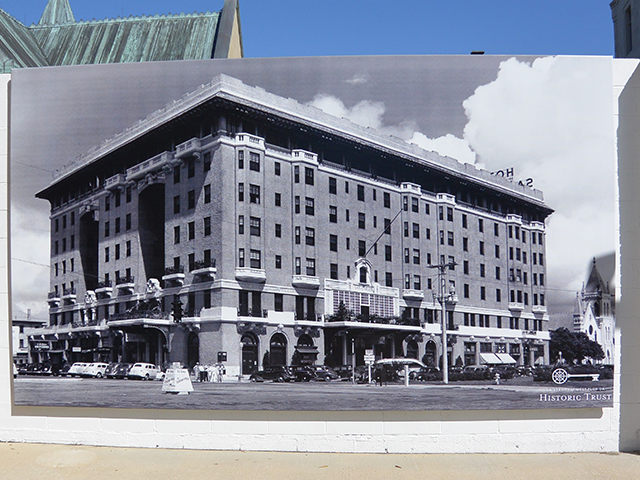
Mural: San Carlos Hotel
Building: Regions Bank
Address: 70 N Baylen Street
The San Carlos hotel, nicknamed “Gray Lady” due to its pearly-gray stucco exterior, sat at the corner of Palafox and Garden Streets. Built with over 150 rooms, she underwent an expansion in 1927 which brought the room total to over 500. Sadly, the Gray Lady closed in 1982, then was demolished in 1993 due to deterioration.
- Exterior of the San Carlos Hotel, ca. 1945
This photograph shows the San Carlos Hotel in the 1940s or early 1950s. By this time, the San Carlos had added a sign to its facade facing St. Michael’s Basilica, announcing its presence to all passersby. - Exterior of the San Carlos Hotel, ca. 1910
The San Carlos Hotel marketed itself as one of the premier destinations in the Southeast. Guests to the hotel enjoyed the finely carpeted interior and amenities including electric lighting, advanced ventilation, and telephone service in each room. Room rates started at $1.50 per day. - Parade for the Commissioning of the USS Florida BB-30, 1911
On September 15, 1911, the navy commissioned the fighting ship USS Florida (BB-30). As a naval city, Pensacola celebrated the commissioning with a large parade. Here, sailors and civilians alike gather in front of the San Carlos hotel to listen to speakers from the second-floor balcony. - Visitors to the San Carlos Hotel, ca. 1920s
Besides providing guests a place to stay, the San Carlos held a variety of events like dinners, dances, and concerts. Whatever the occasion, the visitors in this photograph are properly dressed for the elegance that awaits them inside. - Exterior of the San Carlos Hotel, ca. 1911-1924
The San Carlos graced the northwest corner of Palafox St. and Garden St., the present-day location of the Escambia County Courthouse. This site has long served as a junction at which the lives of people of different backgrounds intersected. Housekeepers, barbers, waitresses, court reporters, and IT workers have all found themselves at this location throughout the years. - The Lobby, pre-1930s
For 83 years, Pensacola locals and visitors alike entered the extravagant lobby of the San Carlos Hotel. Guests gazed upon ornate high ceilings, the grand staircase, and decorative furniture. This picture became a postcard in 1932. - Colored Glass Dome
In the San Carlos lobby, sunlight shone through a giant colored glass dome and down onto a white marbled floor. The whiteness of the marble provided extra light. The San Carlos used natural lighting wherever possible. - The Reading Room
San Carlos guests lounged in this room to read the daily paper or their favorite book. A skylight shed natural light into the room, allowing guests to enjoy the sun. Carpets and furniture in the San Carlos Hotel were of Spanish influence in design and color. - Interior Lobby Elevators
The Garden Street entrance of the San Carlos led guests past the elevators and toward the grand staircase, marble archway, and finally the patio. A wrought-iron gate separated the patio from the hotel lobby. The patio ceiling had glass between the beams. Candelabras illuminated patrons from above. - San Carlos Employees, 1941
Twenty-year-old Robert Martin Jr. (left) worked as a steward at the San Carlos Hotel in 1941. The hotel boasted a dining room, electric grill, bakery, coffee shop, and banquet hall. The menu changed daily. Guests dined on items like broiled Spanish mackerel, candied sweet potatoes, and tutti frutti ice cream. - Interior Dining Room
The San Carlos Hotel’s dining room, known as one of the finest in the Southeast, was famous for its coffee and southern hospitality. Orchestras played from the overlooking balcony. By day, the adjoining patio provided natural light. By night, electric chandeliers lit the room. Traveling guests enjoyed the inviting atmosphere, and local patrons stopped by daily for coffee and chatting. Many important business transactions occurred during this popular café hour. - San Carlos Hotel Bus Stop, c. 1950
Nestled in the business district, the San Carlos Hotel served as a stop for Pensacola’s public bus system. This photograph shows the segregation of bus passengers. The Avery Bill enforced Jim Crow laws in the city until 1962. Advocacy for the abolishment of segregation rose in the 1950s, as cities in the region launched bus boycotts, including Tallahassee, Baton Rouge, and Montgomery. - Military Parade, 1938
On December 3, 1938, the city held a military parade to honor the men and women serving at Naval Air Station Pensacola. The U.S. Naval Reserve Act permitted the enlistment of qualified women as nurses earlier in the year. Nurses marched alongside sailors down Palafox Street in front of the San Carlos Hotel.